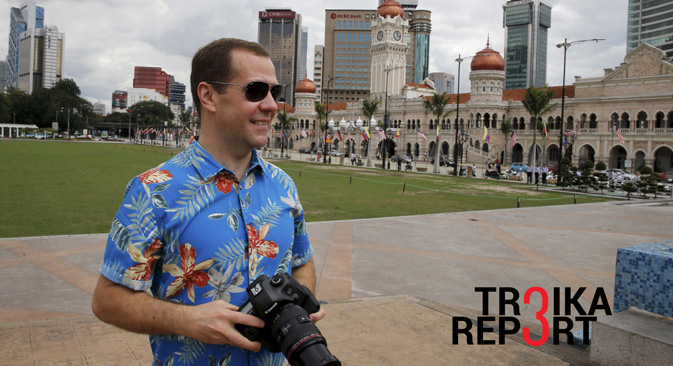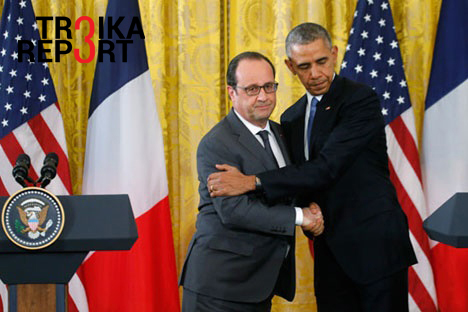Asia-Pacific: Moscow switches its focus to Southeast Asia

Russia's Prime Minister Dmitry Medvedev seen by the Sultan Abdul Samad Building in Independence Square, Nov. 22, 2015
ReutersCould Russian Prime Minister Dmitry Medvedev’s extensive tour of Asia convince skeptics that Russia’s “pivot to Asia” has substance apart from style? The recent flurry of diplomatic efforts showed that while Russia is still dragging its feet, Putin’s team still has real hopes of jumping on the bandwagon, but has become more selective in its approach.
Immediately after attending the Asia-Pacific Economic Cooperation (APEC) summit in Manila, Medvedev flew to Kuala Lumpur, Malaysia, to be present at the 18 nations’ assembly at the 10th East Asia Summit (EAS). Since EAS is the vehicle of engagement between the Association of Southeast Asian Nations (ASEAN) and “outside” partners, showing the flag had at least a symbolic meaning.
On top of it, Medvedev’s talks on furthering bilateral relations with Malaysia were followed by his visit to Cambodia, which is undergoing a dramatic evolution to become more open to the outer world.
Yet leading Russian experts engaged by Troika Report warned against downplaying the event, arguing that in its “pivot to Asia” Moscow, out of pragmatic considerations, has in fact shifted its emphasis from the APEC to engaging the EAS. Dr. Dmitry Mosyakov, director of the Center for South East Asia, Australia and Oceania at the Institute of Oriental Studies, Russian Academy of Sciences, made this comment for Troika Report.
“It is no big secret that the APEC, which used to be the focus point of Russia’s policy in the region, has come to be viewed by many member states as a overblown bureaucratic organization often pursuing a global political agenda, like fighting international terrorism, but less devoted to promoting free trade in this part of the world. In contrast, the East Asia Summits (Russia joined the EAS in 2008) are dedicated to trade tariffs, defining trade rules, and facilitating free flow of goods and capital. Besides, Moscow is becoming uneasy with the U.S. dominance in the APEC.
“On the other hand, bilateral negotiations on the sidelines of the EAS were no less important. The visit by Prime Minister Medvedev was a show of support to Malaysian Prime Minister Najib Razak, who is under serious pressure, with oppositional forces determined to oust him and, subsequently, redirect foreign policy and turn it unilaterally pro-West.”
This raises the question to what extent Russia is committed to promoting multifaceted (political, above all) relations with Southeast Asia, where it has kept a low profile until recently. Dr. Mosyakov pointed out that upgrading the status of the dialogue with the EAS is telling: Moscow is definitely gambling on this particular vehicle of cooperation.
This viewpoint was echoed by Yekaterina Koldunova, who is deputy dean at the School of Political Affairs, associate professor at the Department of Asian and African Studies, and a senior expert with ASEAN Center at the Moscow State Institute of International Relations. She sounded upbeat about the “pivot” specifically to the EAS.
“Russia is enhancing its trade with the ASEAN. Turnover is approaching 1 percent of the ASEAN total. This trade volume is not big, but in the past 10 years it has grown fivefold. Actually, there is a certain trend: First, Russia is slowly upgrading its relations with ASEAN countries, and second, the political elite is exploring opportunities for further development on this track.”
– Is it only at the stage of exploring opportunities?
“There were lots of laments by ASEAN member states that Russia has been underrepresented at the summits of this organization. The Russian foreign minister was a frequent visitor but the president of Russia never attended them, with the exception of the very first gathering when he was the personal guest of Malaysian Prime Minister Mahathir Mohamad. For the last two years, the level has been upgraded, and it is the Russian prime minister who heads the delegation which traditionally attends various forums in Southeast Asia.”
After the fanfares sounding loud at the Vladivostok APEC summit, the present tacit re-direction toward the EAS comes as a cold shower for the champions of this ambitious endeavor.
But what does Russia have to offer Southeast Asia? Symbols apart, the export potential of Russia’s economy, limited to hydrocarbons, nuclear power generation technology and military hardware, does not provide the necessary basis for solid partnership.
Moreover, it is hardly conceivable that Moscow is ready to plunge headlong into the multitude of regional rivalries and internal conflicts. It is more likely that Putin’s strategists would limit their efforts to deepening integration with a carefully selective group of partners like China, South Korea, and Vietnam. But if the current interaction with Southeast Asian nations pays off, then the ASEAN might become Russia’s gateway to the whole Asia-Pacific region.
The opinion of the writer may not necessarily reflect the position of RBTH or its staff
Russia-Ukraine flight ban: A month in>>>
All rights reserved by Rossiyskaya Gazeta.
Subscribe
to our newsletter!
Get the week's best stories straight to your inbox

